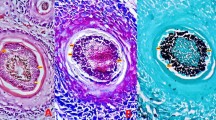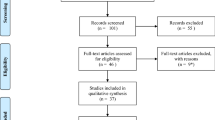Abstract
Introduction
Tinea capitis is a scalp infection caused by different fungi. Etiological diagnosis is based on suggestive clinical findings and confirmation depends on the fungus growth in culture. However, it is not always possible to perform this test due to lack of availability. The association of clinical and dermatoscopic findings in suspected cases of tinea capitis may help the identification of the etiological agent, facilitating precocious, specific treatment.
Materials and method
We report a prospective descriptive analytical study of 34 children with tinea capitis. We performed a trichoscopic examination of all patients; only six children were able to have the mycological culture.
Results
Trichoscopy was abnormal in all 34 patients; it showed hair shaft abnormalities and, in some cases, scalp disorders too. We found that the comma and corkscrew appearance was found in microsporic tinea capitis, V-shaped hair was mainly seen in inflammatory tinea capitis, scales and follicular keratosis in non-inflammatory tinea capitis, and crusts and follicular pustules in inflammatory tinea capitis. Finally, erythema was seen in trichophytic and inflammatory tinea capitis.
Conclusion
We propose a classification of trichoscopic signs of tinea capitis. This classification will enable rapid diagnosis and prediction of the type of fungus before mycological culture, thus a faster and more adapted management.
Our study shows the importance of trichoscopy in the diagnosis and monitoring of tinea capitis. We suggest further prospective studies with a larger number of patients with tinea capitis, having performed mycological culture, to confirm this classification.
Similar content being viewed by others
Introduction
Tinea capitis (TC) is the most common dermatophytosis in children [1, 2]. In some situations, the appearance and clinical context are not obvious requiring mycological confirmation. However, the culture results can take 4 weeks to be available, which may hinder the management of these patients and increase the risk of contamination [3]. In these cases, trichoscopy can guide the diagnosis. Therefore, dermoscopic signs specific to TC must be well established.
Materials and method
We carried out a 6-month prospective descriptive analytical study between January and June 2017, gathering the various dermoscopic signs found in children with alopecic plaques suspected of TC. We classified them according to the clinical patterns of microsporic TC, trichophytic TC, or inflammatory TC, in order to find a correlation between the dermoscopic signs and the clinical subtype. The data were saved on Excel and analyzed on the SPSS Statistics version 20 software.
Results
We collected data from a total of 34 children with alopecic plaques highly suggestive of the diagnosis of TC. The average age of our patients was 8.42 years (3–14 years). Out of the 34 children, 67.6% were boys and 32.4% girls, with a sex ratio of 2.09. Out of the 34 children, 47.51% had microsporic TC, 29.4% trichophytic TC, and 23.5% inflammatory TC (Table 1). Only six patients were able to have a mycological culture to confirm the diagnosis of TC as well as the clinical subtype; all the children received probabilistic treatment with good evolution. The other 28 patients did not have a mycological culture because of a lack of financial means. Under the dermoscope, the signs found were: broken hair (91.2%), follicular keratosis (82.4%), scales (85.3%), black dots (73.5%), bent hair (70.6%), erythema (64.7%), comma hairs (55.9%), crusts (50%), corkscrew hairs (35.3%), forked hairs (32.4%), bar code-like hair (26.5%), follicular pustules (23.5%), zigzag hair (17.6%), translucent hair (11.8%), and V-shaped hair (11.8%; Fig. 1). We did not observe a classic dermoscopic sign of alopecia areata.
Univariate analysis showed that: the sign of corkscrew hair was significantly present in female children (p < 0.05, r = 0.016), comma hair and corkscrew hair were found in microsporic TC (p < 0.001, r = 0.685 and p < 0.05, r = 0.536, respectively; Figs. 2 and 3), V-shaped hair was mainly seen in inflammatory TC (p < 0.05, r = 0.017; Figs. 4 and 5), crusts and follicular pustules in inflammatory TC (p < 0.05, r = 0.061 and p < 0.001, r = 0.000, respectively; Fig. 6), scales and follicular keratosis in non-inflammatory TC (p < 0.001, r = 0.000 and p < 0.05, r = 0.038, respectively; Figs. 7 and 8), and, finally, erythema was seen in trichophytic and inflammatory TC (p < 0.001, r = 0.889; Table 2).
Dermoscopic image corresponding to the inset square of Fig. 2
Dermoscopic image corresponding to the inset rectangle of Fig. 4
Dermoscopic image corresponding to the inset rectangle of Fig. 4
Dermoscopic image corresponding to the inset rectangle of Fig. 7. The orange arrowheads are pointing for scales and follicular keratosis, the yellow ones for broken hairs, the blue ones for bent hairs
Discussion
In 2008, Slowinska et al. described for the first time the sign of comma hair in two children with TC [4]. In 2011, Hughes et al. reported the sign of corkscrew hair in six black children, especially in cases of Trichophyton soudanense infection [5]. The authors suggested that corkscrew hair could be a variant of comma hair in black patients, or a specificity of TC due to Trichophyton soudanense [5]. Our study confirms the specificity of these two signs in TC since they disappeared during probabilistic treatment (Figs. 9 and 10). These two signs are often found simultaneously, with the same patient, which could be explained by the fact that our population is of an intermediate skin phototype (Fig. 11).
Dermoscopy 6 weeks after probabilistic treatment of the plaque shown in Fig. 11
A study carried out in 2015 on four patients with microsporic tinea and two with trichophytic tinea showed that comma hair was specific to trichophytic tinea caused by Trichophyton tonsurans, while the bent hair of microsporic tinea was caused by Microsporum canis [6]. The Bourezane and Bourezane study of 24 patients with TC showed that infection caused by endothrix agents was responsible for abnormalities in hair shape, infection caused by ectothrix agents was responsible for abnormalities in hair color, and finally infection caused by both ectothrix and endothrix agents presented as a mixed dermoscopic pattern [7]. This is in contrast to the results of our study, where comma hairs and corkscrew hairs were significantly present in microsporic tinea (Figs. 3 and 12).
These results seem interesting when considering the choice of probabilistic treatment, especially with the emergence of species more sensitive to terbinafine than to griseofulvin. As reported in the guidelines of management of TC in England, the first-line treatment is terbinafine for trichophytic tinea, which is an allylamine that acts on the cell membrane and is fungicidal, and griseofulvin for microsporic tinea, which is a fungistatic drug that inhibits nucleic acid synthesis, arrests cell division at metaphase, and impairs synthesis of the cell wall [8, 9]. However, these studies require a broader validation; in particular, some studies have not confirmed the correlations between dermoscopic signs and the type of pathogen [10,11,12].
Other studies have highlighted the importance of trichoscopy in monitoring patients with TC [13, 14].
Limitations of the study
Mycological confirmation (direct examination and culture) was not available for all patients. The authors classified patients according to the clinical pattern, in microscopic TC, trichophytic TC, or inflammatory TC, in order to make a correlation between the dermoscopic signs and the clinical subtype.
Conclusion
In conclusion, trichoscopy is a simple, fast, and inexpensive method for diagnosing and monitoring TC in children. However, mycology remains the gold standard for diagnostic confirmation, which is also inexpensive but can take a long time. Confirmation of our results by dermoscopy/mycology correlation in large studies will allow us to treat patients only on the basis of the dermoscopic signs.
References
Abdel-Rahman SM, Farrand N, Schuenemann E, Stering TK, Preuett B, Magie R, et al. The prevalence of infections with Trichophyton tonsurans in schoolchildren: the CAPITIS study. Pediatrics. 2010;125(5):966–73.
Mirmirani P, Tucker L-Y. Epidemiologic trends in pediatric tinea capitis: a population-based study from Kaiser Permanente Northern California. J Am Acad Dermatol. 2013;69(6):916–21.
Moriarty B, Hay R, Morris-Jones R. The diagnosis and management of tinea. BMJ. 2012;345:e4380. https://doi.org/10.1136/bmj.e4380.
Slowinska M, Rudnika L, Schwartz RA, Kowalska-Oledzka E, Rakowska A, Sicinska J, et al. Comma hairs: a dermoscopic marker for tinea capitis: a rapid diagnostic method. J Am Acad Dermatol. 2008;59:S77–9.
Hughes R, Chiaverini C, Bahadorian P, et al. Corkscrew hair: a new dermoscopic sign for diagnosis of tinea capitis in black children. Arch Dermatol. 2011;147:355.
Schechtman RC, Silva NDV, Quaresma MV, Bernardes-Filho F, Bernardes-Filho F, Buçard AM, Sodré CT. Dermatoscopic findings as a complementary tool on the differential diagnosis of the etiological agent of tinea capitis. An Bras Dermatol. 2015;90(3 Suppl 1):S13–5.
Bourezane Y, Bourezane Y. Analysis of trichoscopic signs observed in 24 patients presenting tinea capitis: Hypotheses based on physiopathology and proposed new classification. Ann Dermatol Venereol. 2017; https://doi.org/10.1016/j.annder.2016.12.012.
Ferguson L, Fuller LC. Spectrum and burden of dermatophytes in children. J Infect. 2017;74:S54–60.
Fuller LC, Barton RC, Mohd Mustapa MF, Proudfoot LE, Punjabi SP, Higgins EM. British Association of Dermatologists’ guidelines for the management of tinea capitis 2014. Br J Dermatol. 2014;171(3):454–63.
Sandoval AB, Ortiz JA, Rodríguez JM, Vargas AG, Quintero DG. Dermoscopic pattern in tinea capitis. Rev Iberoam Micol. 2010;27(3):151–2.
Isa RI, Amaya BY, Pimentel MI, Arenas R, Tosti A, Cruz AC. Dermoscopy in tinea capitis: a prospective study on 43 patients. Med Cutan Iber Lat Am. 2014;42(1–3):18–22.
Brasileiro A, Campos S, Cabete J, Galhardas C, Lencastre A, Serrão V. Trichoscopy as an additional tool for the differential diagnosis of tinea capitis: a prospective clinical study. Br J Dermatol. 2016;175(1):208–9.
Campos S, Brasileiro A, Galhardas C, Apetato M, Cabete J, Serrão V, Lencastre A. Follow-up of tinea capitis with trichoscopy: a prospective clinical study. J Eur Acad Dermatol Venereol. 2017;31(11):e478–80.
Vazquez-Lopez F, Palacios-Garcia L, Argenziano G. Dermoscopic corkscrew hairs dissolve after successful therapy of Trichophyton violaceum tinea capitis: A case report. Australas J Dermatol. 2012;53:118–9.
Acknowledgements
Not applicable.
Funding
The authors declare no funding.
Availability of data and materials
Not applicable.
Author information
Authors and Affiliations
Contributions
All the authors contributed to: the interpretation of data for the work; drafting the work or revising it critically for important intellectual content; the final approval of the version to be published; and the agreement to be accountable for all aspects of the work in ensuring that questions related to the accuracy or integrity of any part of the work are appropriately investigated and resolved.
Corresponding author
Ethics declarations
Ethics approval and consent to participate
The study has been approved by the ethics committee of Faculty of Medicine of Fez.
An informed consent to participate in the study was obtained from the legal guardians.
Consent for publication
Written informed consent was obtained from the patients’ legal guardians for publication of this study and any accompanying images. A copy of the written consents is available for review by the Editor-in-Chief of this journal.
Competing interests
The authors declare that they have no competing interests.
Publisher’s Note
Springer Nature remains neutral with regard to jurisdictional claims in published maps and institutional affiliations.
Rights and permissions
Open Access This article is distributed under the terms of the Creative Commons Attribution 4.0 International License (http://creativecommons.org/licenses/by/4.0/), which permits unrestricted use, distribution, and reproduction in any medium, provided you give appropriate credit to the original author(s) and the source, provide a link to the Creative Commons license, and indicate if changes were made. The Creative Commons Public Domain Dedication waiver (http://creativecommons.org/publicdomain/zero/1.0/) applies to the data made available in this article, unless otherwise stated.
About this article
Cite this article
Aqil, N., BayBay, H., Moustaide, K. et al. A prospective study of tinea capitis in children: making the diagnosis easier with a dermoscope. J Med Case Reports 12, 383 (2018). https://doi.org/10.1186/s13256-018-1914-6
Received:
Accepted:
Published:
DOI: https://doi.org/10.1186/s13256-018-1914-6
















